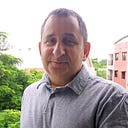A Specific Use Case
My March 10, 2002, article titled “Quantum Error Ignoration” used a quantum walk as a practical example: for two qubits, imagine you have three valid directions of travel and one invalid direction of travel; you simply cannot travel in an invalid direction. So, if environmental noise tells you to go in the impossible fourth direction, you simply ignore that result and run the circuit again and again until you get a valid result. For another example, let’s download and read “Teaching Qubits to Sing: Mission Impossible?” This is actually the algorithm for which I developed the concept of “error ignoration” in the first place.
So, imagine we have a sequence of three notes: A-B-C. For you music aficionados out there, I apologize for the gross oversimplification. But, anyway, imagine we have encoded into the amplitudes of the qubits that whenever we have the three-note sequence A-B-C we want a 70% probability that the next note in our new composition will be a D and a 30% probability that the next note in our new composition will be an E. The source of these probabilities is detailed in the paper, of course.
The problem is that NISQ-era quantum computers are plagued with noise. So, what happens if we get a noise-induced F, for example, instead of a D or an E? We could consider celebrating the inherent…
